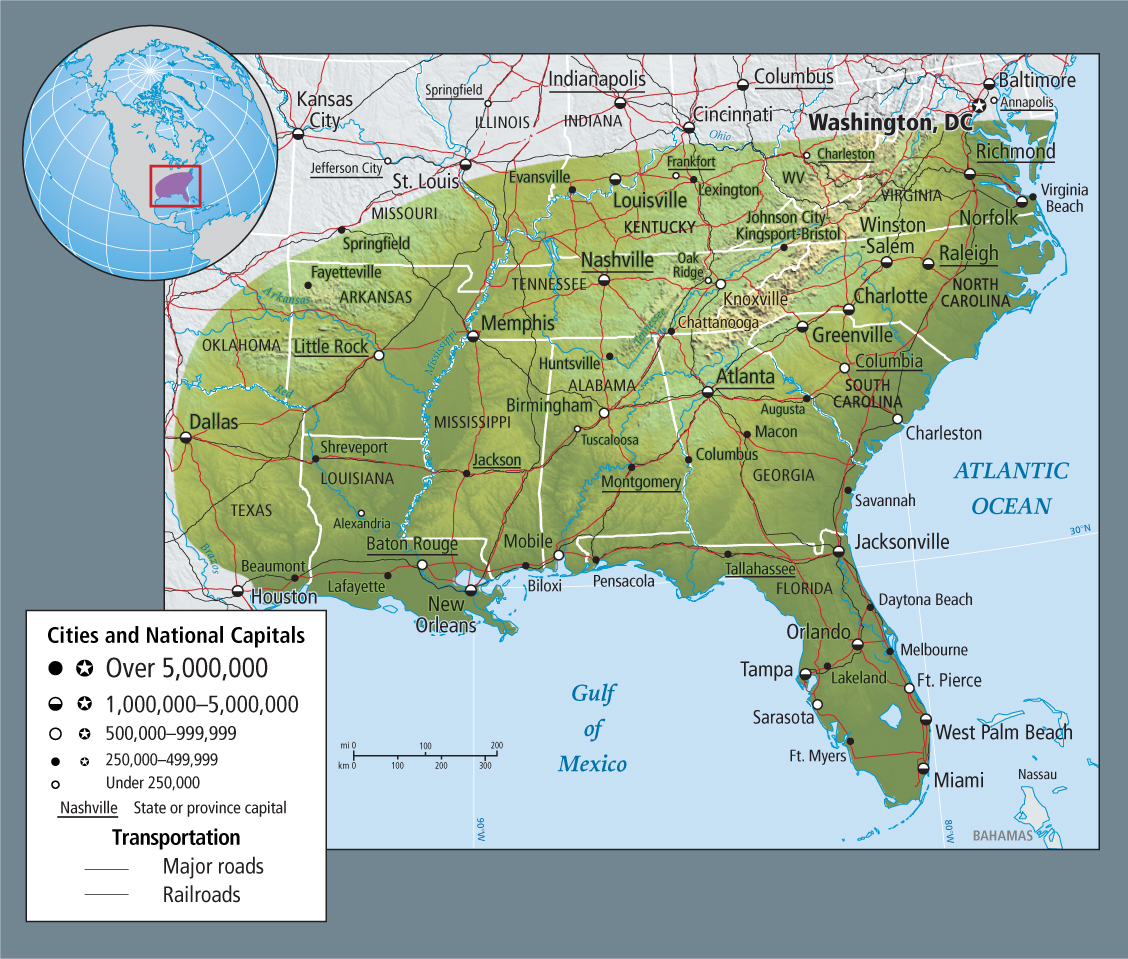The American South (The Southeast)
The regional boundaries of the American South are perhaps less distinct and based more on a perceived state of mind and way of life than most other U.S. regions. This region, in fact, covers only the southeastern part of the country, not the whole of the southern United States (Figure 2.44). Somewhere east of Austin, Texas, the American South grades into the Southwest, a region with noticeably different environmental and cultural features.

111
Multiple Images Characterize the South
The American South is dominated by a complex of features that many people would identify as Southern: a wide range of dialects; barbecue and other comfort foods from both white and African American traditions (see Figure 2.26A); stock car racing; horse farms; bluegrass, jazz, country, and blues music; the Baptist version of Christianity; the open friendliness of the people; conservative stances on politics, gun ownership, patriotism; the prominent role of religion in public life; the early onset of spring; and rural settlement patterns, such as those that keep large kin groups together in clusters of old wooden cabins, mobile homes, or finely built new houses.
Some places located in the South have few recognizable Southern qualities (Figure 2.45). Parts of Missouri, Oklahoma, and Texas have strong ties to the Great Plains; Miami, on the far southern tip of Florida, with its cosmopolitan Latino culture and its trade and immigration ties to the Caribbean and South America, hardly seems Southern at all. New Orleans, also in the heart of the South, has a unique set of cultural roots—French, African, Cajun, Creole—that set it apart from other Southern cities.

North Americans and foreign visitors to the South tend to hold many outdated images from the civil rights era of the 1960s and even from the Civil War era. It is true that significant racial segregation still persists in that black people and white people tend to live and worship separately, but in fact, many more whites and blacks share neighborhoods in the South than in the old economic core. And increasingly in rural and urban settings, schools are integrated as a result of residential patterns as well as busing plans and magnet schools. The workplace is now integrated, and it is not uncommon to find African Americans and other minorities in supervisory and administrative positions, especially in business, government, and educational institutions. And biracial families are common.
Since the 1990s, Hispanic immigrants have come by the thousands into Southern cities. Of the 11 U.S. cities with the largest Hispanic populations, 3 are in the Southeast. Much of the restaurant service, road maintenance, landscaping, roofing, and construction work is now done by Spanish-speaking workers from Mexico and Central America, many of whom are sinking roots in the region and saving to establish businesses and buy homes.
Poverty Persists for Some, But Return Black Migration Is a Boon
The South has the nation’s highest concentration of families living below the poverty line, and most of them are white. On the other hand, most Southerners—black, white, or Hispanic—are able to maintain a substantially better standard of living than their parents did.
Many who left the South in the 1950s and 1960s for factory jobs in the old economic core in the Great Migration have come back to the region because of jobs, business opportunities, the lower cost of living, a milder climate, as well as safer, more spacious, and friendlier neighborhoods than the ones they left in places such as New York, Illinois, or California. This return is being called the New Great Migration. In the decade of the 1990s, 3.5 million people who self-identified as black moved to the South from other parts of the United States. Seven of the ten metropolitan areas that gained the most black migrants during the 1990s were in the South, principally in Florida, Georgia, North Carolina, Virginia, Tennessee, and Texas. Other Southern states saw no increase, and Louisiana experienced black out-migration even before Hurricane Katrina. Since 2000, half a million new black residents have moved to Atlanta, many of them young, educated professionals. Another 500,000 of Atlanta’s newest citizens are Hispanic, and Asians constitute another substantial minority.
112
The South is steadily improving its position as a growth region. The federally funded Interstate Highway System opened the region to auto and truck transportation. Inexpensive industrial locations, close to arterial highways, have drawn many businesses to the South, including those involved in automobile and modular-home manufacturing, light-metals processing, high-tech electronics assembly, and high-end crafts production. For several decades, tourists and retirees by the hundreds of thousands have been driving south on the interstate highways, many attracted by the bucolic rural landscapes, the historic sites, the warm temperatures, the natural environments of its national parks, the outlet mall shopping, and the recreational theme parks.
Southern agriculture is now mechanized, and it is at once more diversified and more specialized than ever before. Strawberries, blueberries, peaches, tomatoes, mushrooms, and wines from local vineyards are replacing the traditional cash crops of tobacco, cotton, and rice. Those who produce these often organically grown luxury crops for urban consumers often do so on smallholdings as part-time farmers who may also have jobs in nearby factories or service agencies. Most of the country’s broiler chickens are now produced by large nonorganic operations throughout the South. Interestingly, the laborers willing to take low-wage jobs on these factory-like chicken farms are often immigrants from places such as Russia, Ukraine, Vietnam, Haiti, and Honduras.
THINGS TO REMEMBER
 The regional boundaries of the American South are perhaps less distinct and based more on a perceived state of mind and way of life than most other U.S. regions.
The regional boundaries of the American South are perhaps less distinct and based more on a perceived state of mind and way of life than most other U.S. regions. While the South still remains the subregion with the nation’s highest poverty rate and lowest educational attainment, the region is growing in population, number of businesses, and high-tech industries; it is improving with regard to its overall human well-being; and it is increasingly becoming the choice of residence for immigrants from all over the world.
While the South still remains the subregion with the nation’s highest poverty rate and lowest educational attainment, the region is growing in population, number of businesses, and high-tech industries; it is improving with regard to its overall human well-being; and it is increasingly becoming the choice of residence for immigrants from all over the world. Contrary to popular belief, most families living below the poverty line are white.
Contrary to popular belief, most families living below the poverty line are white.